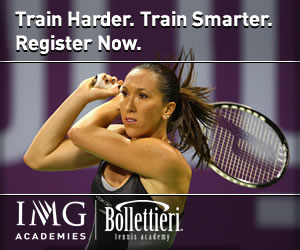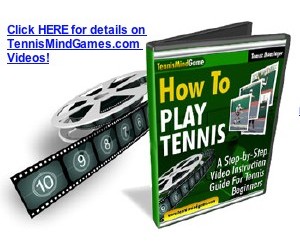July 1997 Article Turbo Tennis Archives:
Tennis Server
|

 |
Normally, tennis is a game for two to four players. Occasionally, we see an odd numbers of participants training together (as in two on one drills) or when a fourth cannot be found (Canadian doubles). Yet, there seems to be little one can do when she/he finds himself/herself alone. Well, that just isn't so and here are some ideas to help in that situation.
THE BACKBOARD AND/OR WALLAlthough the value of hitting against a wall or backboard has been and is debated, almost every great or not so great player has spent a good amount of time practicing in such a manner. Poncho Segura spent many hours as a youth hitting against a wall. John McEnroe is reputed to have developed his legendary volleys by hitting against a backboard. Like it or not, the wall or backboard is a necessity at times...one that I believe can be invaluable. In fact, I spend a good number of hours during the winter months (New England is cold and snowy at this time of year) using a wall in the gymnasium at the college where I teach or a racquetball court wall in the same facility. I have a friend who has actually marked a net line on his basement wall. When he is unable to get out, find a partner or time is at a premium, he retreats to this "underworld" to practice groundies and volleys. Many parks in the U.S. have large walls or backboards located adjacent to courts. Most clubs will provide a backboard on one or more tennis courts. Usually racquetball court time is less expensive than tennis court time during the "indoor season." Suffice it to say, I'll bet there is a suitable wall near you...it may even be your garage wall... it may be the side of a building. The first task is to find your hitting backboard/wall.
Next, I will hit 200 sliced strokes in the same manner as above. For these, I move a bit closer to the wall (about 6 to 8 feet closer). The purpose here is to perfect the forehand and backhand slice approach. All that is lacking is the true approach to the wall since you do not follow the ball in after making contact. However, I assure you that this drill will help you to hit the slice approach correctly. Then, I hit 500 volleys from a distance of about 6 to 10 feet from the wall/backboard. Here, I hit more randomly...the way volleys come at you. At this distance from the wall, you will notice that the hard hit or "crisp" volleys force you to react quickly. The softer volleys allow you to try for more control...both essential ingredients in the net game. Overheads are next. I practice these by hitting the ball at the ground first at such an angle that it bounces, hits the wall/backboard and comes off this barrier at an upward angle. These are perfect for practicing the smash. The only real drawback is that you must catch or block each ball after hitting the overhead, stop and then, begin the process again (unfortunately, it is impossible to hit these without interruption). I try to hit about 50 of these each practice session. Finally, I practice serves...off the wall. I hit at least 100 to 150 serves (both first and second) every session. I make certain the ball strikes the backboard at near net height or higher and bounces within 10 to 15 feet of the wall. In this way, you can be reasonably certain that the serves are "in." Add all of these together and I hit between 1350 and 1400 balls. It usually takes me about an hour to an hour and a half to go through the entire ritual. Not bad, when you have limited time to practice. Hitting on the wall greatly enhances your timing and makes grip changes "automatic." Yes, you do hit harder against the wall than you do "on court," but this is easily adjusted. First, don't use balls that are dead or over used. I use new balls (I open a new can) for every practice session using a backboard or wall. Second, try to spin some of your shots (both slice and topspin). By doing this, you will avoid overhitting. Finally, try to vary the height of your balls as you hit them. This, too, will help minimize the "power" effect of wall or backboard hitting.
One final tip, if you take a thick board (about 10 feet by 8 feet) and lean it up against a wall at an angle of 45 to 60 degrees, you will have an excellent volley backboard. Hitting volleys against this type of backboard greatly enhances the underspin or slice that good volleys have. The balls come off this board at an upward angle and force you to volley down. Try it...you'll like it. In addition, its easy to set up this type of volley board in your garage or basement...convenient places to practice!
THE BALL MACHINEI swear by ball machines! I own a Tennis Tutor II which is battery operated, rechargeable and fits easily in the trunk of my car. Prince and others make similar machines. I get about 4 to 5 hours out of a full charge. I can travel to any court (hard, grass or clay) and use it safely.Again, I have a ritual. I hit about 300 backhand groundstrokes, then, 300 forehand groundstrokes. I switch the machine to its oscillation mode and hit about 300 alternating forehand/backhand groundstrokes (on the run...of course). Next, I find myself hitting volleys...usually about 300 to 450 with the machine in its oscillating mode (thus, I am forced to hit both forehand and backhand volleys). Third, I shoot up about 100 lobs and practice overheads. As a final step, I always hit at least a hundred serves. When practicing groundstrokes and volleys, I place targets (usually empty tennis ball containers) around the key areas of the court. These key areas are: deep in both backcourt corners, deep and in the center of the backcourt, and inside the service box on both sides near the sideline, These five locations are where you want to direct most of your shots. I find that by practicing with these targets I can actually imagine that they are on court during matches. This visualization greatly improves placement when competing. All in all, I hit about 1200 to 1500 balls in a session. You will want to have a ball hopper because you will spend a good amount of time picking up balls. My machine can hold 150 balls. Usually, I require 2 hours to finish this workout. Most clubs have machines that you can rent by the hour. However, I strongly encourage that you make the investment ($700 to $1000) and get your own. I can truly endorse the Tennis Tutor line. They are simple to use, very portable and easy to fix when something goes wrong. I have had to change the battery once in four years...it was easy and the cost was minimal ($75). Ball machine workouts build consistent strokes, stamina, patience and confidence. Imagine how well you would compete if all of these aspects of your game improved!
SHADOW PRACTICEI must give attribution to Dennis Ralston for developing this form of solo practice. Like a boxer who shadow boxes...you play shadow tennis. You go on court (although any open space is fine) and pretend to hit a ball with your racquet. You serve, hit groundies, volley, go for smashes, etc...all without a ball. Now, I know that some of you will say..."won't I look ridiculous?" Well, maybe a little, but I assure you that this helps your form. If you can really imagine points as you go through all of this feinting, you will be amazed at the benefits to your game. You will greatly improve footwork and court awareness. Please don't discount this form of solo practice. Frequently, before a match, I will spend 15 minutes or so doing shadow tennis as a warm-up. For me, it really gets me ready to play.
THE SERVEIf you had only one half hour to practice tennis, what would you do? Well, if a court is available, I suggest you go out and practice that serve. This is the single most important stroke in tennis! Yet, I fear most of us don't practice it regularly and deliberately.Start by practicing your second serve. This will limber up your arm, and after all, you are only as good as your second serve. Work on spin and placement. Serve to both deuce and ad courts. Put targets on the service line...one on the "T"...another in the center of each box...and the last on the wide side of each service box. Try to knock these over. This will make certain that your serves land deep in the box. I like to hit about 75 second serves...varying the spin and placement. Then, I hit about 50 first serves where I stay back. Again, I vary the placement, but all of these serves are flat. Finally, I hit about 50 first serves where I am serving and volleying. Here, I vary placement, spin and depth. Be certain to serve equally to both deuce and ad courts. Believe me, if you practiced nothing but your serve, your match record would improve greatly. Remember, you cannot lose a match if you don't lose serve. So, when you can't find a partner, want to work on a specific part of your game, or find yourself with limit time for practicing...remember solo tennis. If you practice in these ways on a regular basis, I promise you that you'll soon become a tennis overdog. Good luck in your game!
1996 - 2002 | 2003 - Present
This column
is copyrighted by Ron Waite, all rights reserved. Questions and comments
about these columns can be directed to Ron by using this form.
Ron Waite is a certified USPTR tennis instructor who took up the game
of tennis at the age of 39. Frustrated with conventional tennis methods
of instruction and the confusing data available on how to learn the
game, Ron has sought to sift fact from fiction. In his seven years of
tennis, Ron has received USTA sectional ranking four years, has successfully
coached several NCAA Division III men's and women's tennis teams to
post season competition, and has competed in USTA National singles tournaments.
Ron has trained at a number of tennis academies and with many of the
game's leading instructors.
In addition to his full-time work as a professor at Albertus Magnus
College, Ron photographs ATP tour events for a variety of organizations
and publications. The name of his column, TurboTennis, stems from his
methods to decrease the amount of time it takes to learn and master
the game of tennis.
|



October 2022 Tennis Anyone: Patterns in Doubles by John Mills. September 2022 Tennis Anyone: Short Court by John Mills. |
 You will join 13,000 other subscribers in receiving news of updates to the Tennis Server along with monthly tennis tips from tennis pro Tom Veneziano.
You will join 13,000 other subscribers in receiving news of updates to the Tennis Server along with monthly tennis tips from tennis pro Tom Veneziano. 

